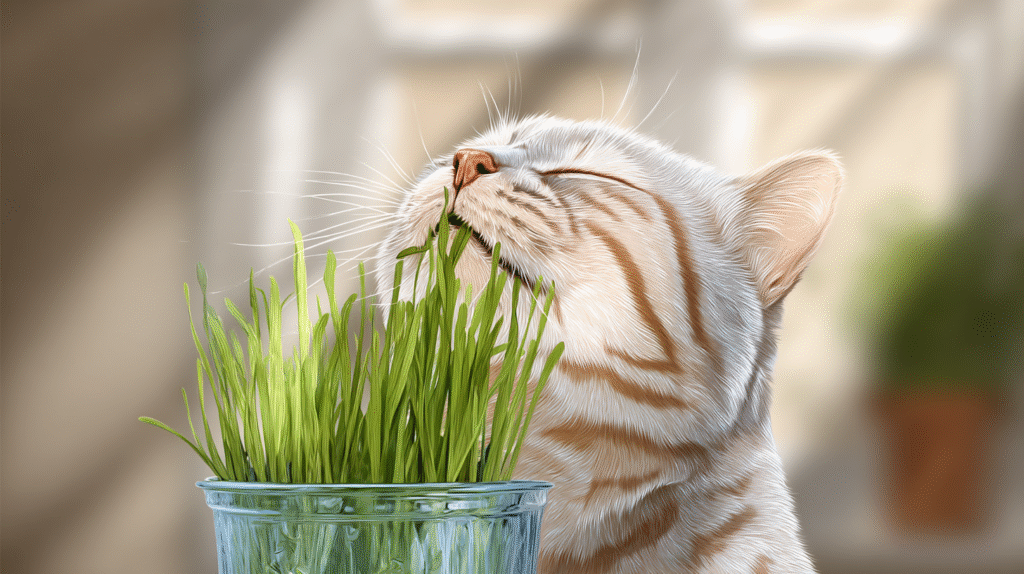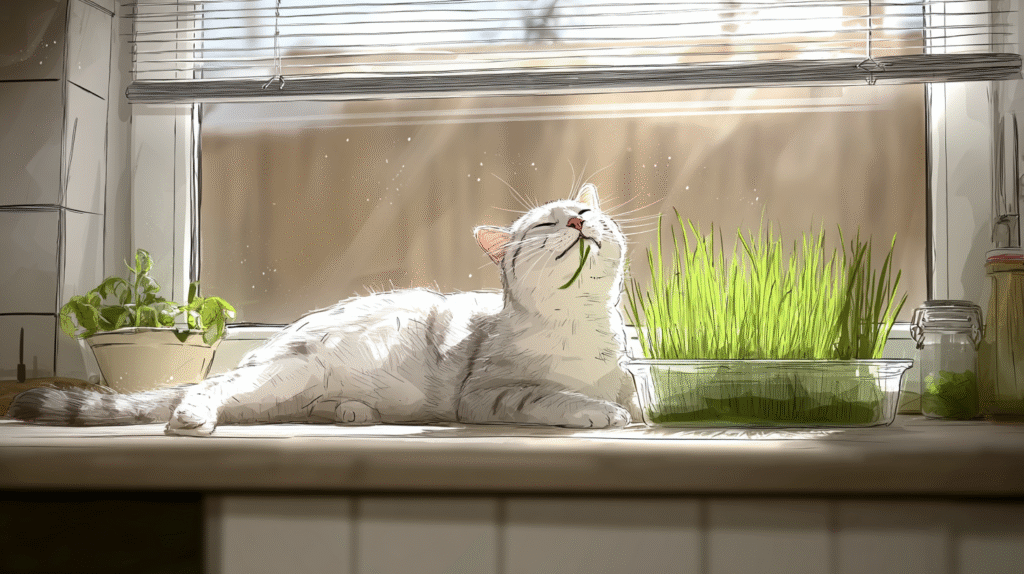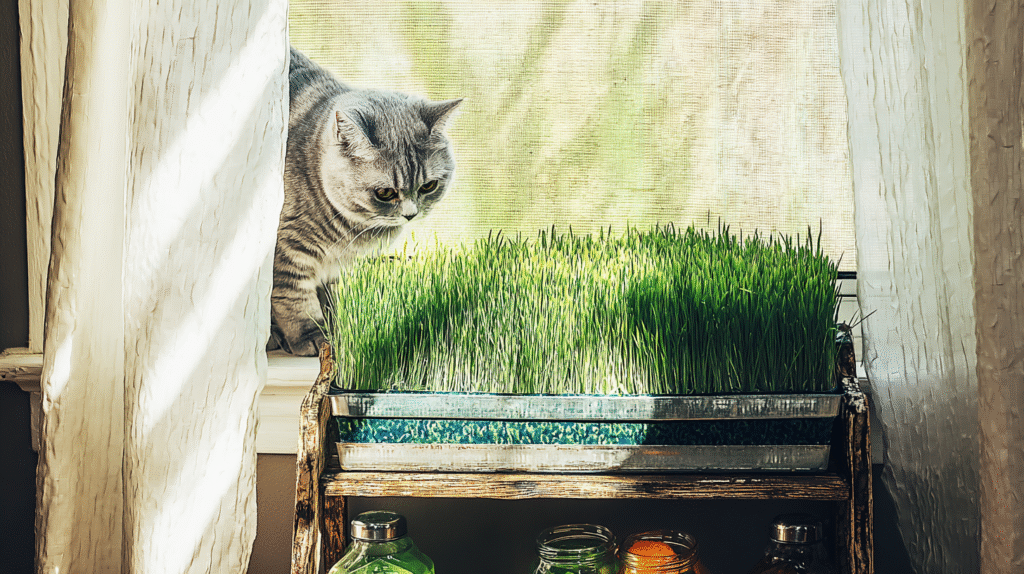My breaking point came when I found my cat, Mochi, munching on my $45 fiddle leaf fig. Again. The spider plant? Destroyed. The prayer plant? Chewed to stumps. Even my supposedly toxic pothos had teeth marks. My apartment looked like a very specific natural disaster hit — one that only targeted plant leaves at cat height.
“She needs grass,” the vet said, like it was obvious. “Cats eat plants for digestion. Give her cat grass.”
Cat grass? I thought that was just wheat grass marketed to cat people. Turns out, I was both right and wrong. And that $3 container of seeds probably saved me hundreds in plant replacements. Now Mochi has her own personal salad bar, and my houseplants finally have leaves again.
Here’s everything I learned about growing cat grass, why cats are obsessed with it, and how to keep a constant supply without losing your mind.
Why Cats Turn Into Plant-Destroying Monsters
Before we talk about growing grass, let’s talk about why your cat is treating your home like an all-you-can-eat salad bar.
Cats eat plants for a few reasons:
- Helps them puke up hairballs (gross but necessary)
- Provides fiber and nutrients
- Boredom or curiosity
- Some cats just like the texture
My theory? Mochi was part cow in a previous life. But really, it’s natural behavior. Wild cats nibble grass all the time. Indoor cats? They’ll settle for whatever green thing you’ve got.
The problem is, many houseplants are toxic to cats. Even “safe” plants aren’t meant to be cat salad. Enter cat grass — the sacrificial plant that saves all others.
What Even Is Cat Grass?
Cat grass isn’t one specific plant. It’s usually:
- Wheatgrass (most common)
- Oat grass
- Barley grass
- Rye grass
Basically, cereal grains before they grow up. You can buy:
- Pre-grown containers ($5-10, lasts maybe a week)
- Seed packets ($3-5, grows dozens of containers)
- Growing kits ($10-15, includes everything)
I started with pre-grown. Mochi demolished it in three days. At $10 a pop, I’d need a second job to fund her grass habit. Seeds it is.
My Foolproof Growing Method (Learned Through Many Failures)
What you need:
- Seeds (I buy in bulk on Amazon)
- Shallow container with drainage (or not, more on that)
- Potting soil or coconut coir
- Plastic wrap or bag
- Spray bottle
- Window or grow light
The process that actually works:
- Container choice matters: I use aluminum pie pans, plastic takeout containers, anything shallow. Drainage holes are nice but not essential since grass lives like 2-3 weeks anyway.
- Fill with soil: About 2 inches deep. Pack it down lightly. I’ve used potting soil, seed starting mix, even coconut coir. All work.
- Seeds go THICK: This was my early mistake — planting sparse like regular grass. Wrong. Cover the entire soil surface. Like, can’t-see-soil thick. They’re growing for weeks, not years.
- Press and water: Press seeds gently into soil. Water until moist but not swampy. Overwatering = mold city.
- The greenhouse trick: Cover with plastic wrap or slip the whole thing in a clear bag. Creates humidity for faster germination.
- Dark start: Put somewhere warm and dark for 2-3 days. Check daily. Soon as you see sprouts, move to light and remove plastic.
- Light and water: Bright window or under a grow light. Keep soil moist with spray bottle. Grass grows FAST.
- Ready in 7-10 days: When grass is 4-6 inches, unleash the beast. I mean, offer to cat.

The Rotation System That Saved My Sanity
One container wasn’t enough. Mochi would destroy it, then stare at my plants while I grew more. Now I run a three-container rotation:
- Container 1: Currently being destroyed by cat
- Container 2: Growing, almost ready
- Container 3: Just planted
Every 4-5 days, I start a new container. Always have grass available. It’s like meal prep but for my cat’s weird salad addiction.
Pro tip: Label containers with planting date. I use masking tape. Otherwise it’s “which one did I plant Tuesday?” chaos.
Common Problems I’ve Solved
Mold (my first enemy):
Too wet + poor air circulation = fuzzy white mold. Now I:
- Water less
- Remove plastic as soon as sprouts appear
- Use fan for air circulation if needed
- Sprinkle cinnamon on soil (natural antifungal)
Grass dying too fast:
Cat grass doesn’t live long anyway, but mine was dying in days. Solution: bigger containers with more soil. Those tiny kits have like half an inch of soil. No wonder they die immediately.
Cat ignoring the grass:
Some cats need encouragement. I:
- Placed grass near her favorite window perch
- Rubbed grass to release scent
- Sprinkled catnip on it (gateway drug)
- Put it next to plants she WAS eating
Growing too slow: Warmth = faster growth. I put containers on top of fridge or near heating vent (not too close). Also, presoak seeds overnight for faster germination.
The Unexpected Benefits
Besides saving my plants, cat grass has:
Reduced hairballs: Mochi pukes way less. My carpet appreciates this.
Entertainment value: Watching her graze like a tiny cow is hilarious. Worth the effort just for this.
Healthier cat: Her coat is shinier, digestion better. Vet says the fiber helps.
Garden therapy: Growing something successfully every week is oddly satisfying. Even if it’s just grass.

Different Grass Types I’ve Tried
Wheatgrass: The standard. Grows fast, cats love it, cheap seeds. This is 90% of what I grow.
Oat grass: Softer texture, Mochi seems to prefer this. Grows slightly slower.
Barley grass: Bit tougher, lasts longer. Good for aggressive chewers.
Mixed seed packs: Fun variety but honestly, cats don’t care about variety. They just want green stuff to chew.
Tips That Made Life Easier
Buy seeds in bulk: Pet store seeds are overpriced. I get pounds of wheatgrass seeds online for what pet stores charge for tiny packets.
Ugly containers are fine: Cat doesn’t care if it’s in a fancy pot or yogurt container. Save money.
Location matters: Put grass where cat hangs out, not hidden in corner. Accessibility encourages use.
Multiple cats = multiple containers: Learned this visiting my sister. Her two cats fought over one grass container. Now she grows two.
It’s okay if it’s ugly: This isn’t decorative. It’s functional. My grass is usually lopsided from cat attacks. That’s success.
Why I’ll Never Stop Growing Cat Grass
It’s been two years since the great fiddle leaf fig incident. My houseplants are thriving. Mochi has her personal grass supply. Peace has been restored to the household ecosystem.
Is it slightly ridiculous to be constantly growing grass for a cat? Maybe. But it’s way less ridiculous than replacing expensive houseplants or rushing to the emergency vet because she ate something toxic.
Plus, there’s something wonderful about providing for your pet in such a simple way. She gets excited when she sees me setting up new containers. She has preferences (oat grass on Wednesdays, apparently). It’s become our thing.

Your Cat Grass Quick Start Guide
Ready to save your plants and make your cat happy?
- Buy wheatgrass seeds in bulk online
- Use any shallow container
- Plant seeds thick, keep moist
- Start new container every 4-5 days
- Accept that it’ll look destroyed
- Enjoy having intact houseplants again
That $3 investment in seeds turned my plant-destroying monster into a happy grass grazer. My plants are grateful. My carpet is cleaner. And Mochi? She’s living her best life, one blade of grass at a time.
Just remember: you’re not growing Instagram-worthy wheatgrass. You’re growing a sacrificial offering to the feline plant gods. Adjust expectations accordingly. 🌱






